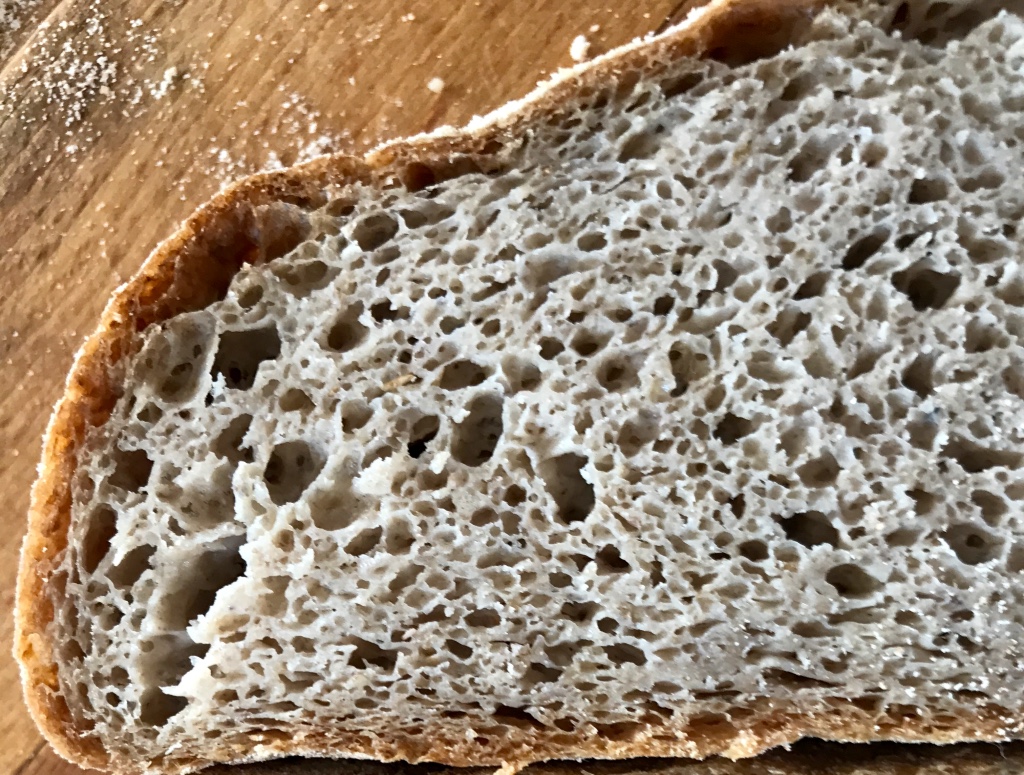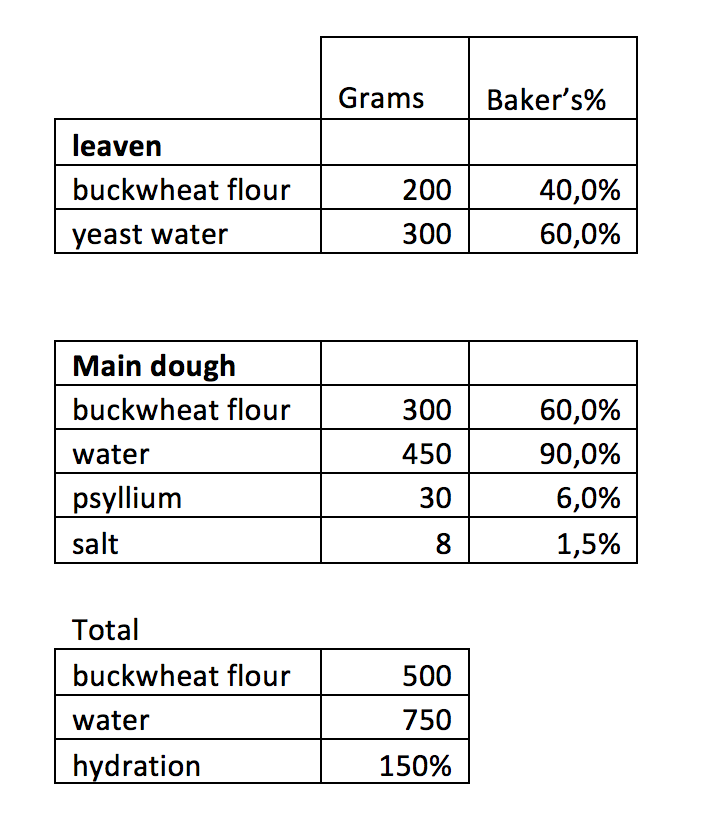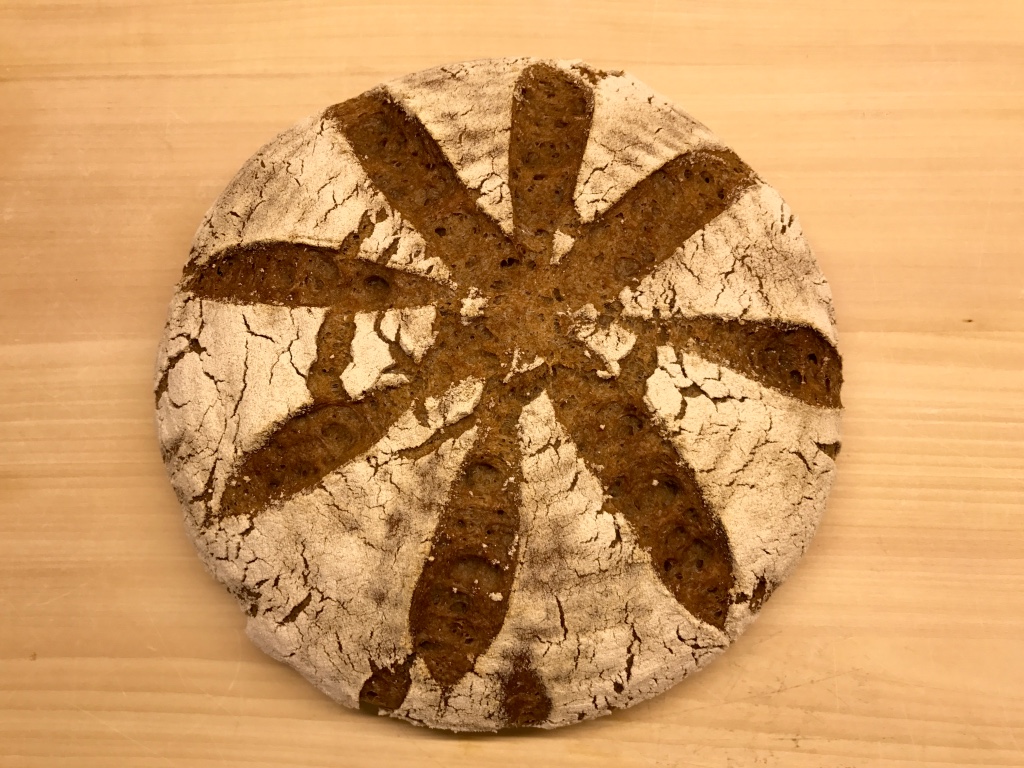
100% buckwheat GF bread leavened with yeast water

This is an improved version of my gluten free 100% buckwheat bread leavened with yeast water. The recipe was tested many times from different enthusiasts and always gave a very good result. It might happen that you will not get so open crumb in first attempt, but the bread will still be tasty and soft like a cake as it contains no gluten.
You can use any active yeast water.


PROCEDURE:
1.) Prepare the leaven - The leaven is built in two stages. Start with 50% of flour and 50% of yeast water – so with 100g of flour and 150g of yeast water. When doubles add the rest of flour and yeast water and wait until doubles again. You can use any active yeast water.
2.) Add the water from the main dough part to the leaven and psyllium and let ferment from 30 - 60 minutes. Then add the buckwheat flour and salt and mix well for at least few minutes on a low speed or mix with hand. Now you can add seeds, walnuts, …
3.) Leave the dough to rest for about 30 minutes and mix with hand for about a minute. Repeat this step again after resting of 30 minutes.
4.) Form a loaf and put it into the proofing basket and let it rise until it almost doubles what might take about 3-5 hours.
5.) Bake in preheated oven at 240 dC covered or with a lot of steam for 10 minutes, then reduce the temperature to 220 dC and bake it for 40 minutes. After that uncover it and bake for next 10 to max 20 minutes. For this last part you may reduce the temperature if the loaf is already well brown.

Happy baking,
Joze


Comments
Wow, what a lovely crumb for GF bread! I wonder - could you use the same formula and procedure for a different blend of gluten-free flours, do you think? Buckwheat flour has quite a strong flavour by itself. Perhaps something with whole sorghum, brown rice and amaranth? Do you use psyllium husk whole or powdered?
Thanks Lazy Loafer!
Yes, indeed I use the same approach for all gluten-free breads. I used the same approach for this GF bread that I have published recently. Psyllium is used as a binder and softener -usually I add 5-6% of whole weight of flour. Most of the time I use yeast water for leavening the GF bread as I don't do them very frequently. Maintaining the sourdough starter would be an overkill because of this. The yeast water gives me much more flexibility so I start preparing leaven about 12 hours or more ahead and always do it in two steps to boost the development of yeast. Usually I add a spoon of molasses to even more stimulate yeast development.
The key in making more open crumb structure is in fermentation. I like YW due to the fact that the result is never sour or has just a bit of sourness which you can really hardly detect.
I use powdered psyllium although I add sometimes also the whole one.
Happy baking,
Joze
While it may not match a wheaten loaf for height, you've gotten an impressive rise out of this gluten-free flour.
How is the texture? At that hydration, my first guess would be that it is very moist, perhaps even gummy.
Paul
Thanks Paul for your good opinion.
The texture is actually very soft, like eating a cake, not chewy at all in comparison with regular bread. The loaf raises very nice during the bake, not so dramatically as gluten bread, but due to weak crumb honeycomb structure it collapses a bit after being baked. So far I have not found a good answer for this. Especially big loaf is prone to this. The bread is kind of moist, but not too much for my taste. With buckwheat it is very easy to get a dry bread which simply fills your mouth and you hardly eat it. According to my experience an acceptable crumb starts probably beyond 120%, but never tried so "dry" version. A 150% hydration is acceptable one from the perspective that you can make a stand alone loaf and gas a good texture. Higher hydration makes the crumb extremely soft and one is surprised when he bites into the bread as the outlook is like a regular bread, but the actual feeling in the mouth is much softer.
I never tried to make it wit xanthan gum or any other binder frequently used for GF breads. Maybe they would give different results but so far I am extremely pleased with this crumb.
Happy baking,
Joze
than it would be with xanthan or guar gum. Everything I've read about those binders indicates that the bread becomes stale and crumbly within one or two days of baking. My limited experience with psyllium is that the bread stays moist and flexible for up to a week.
Paul
Is rejuvelac same thing as yeast water?
I just checked on the net what is the recipe for rejuvelac and it is not the same. Rejuvelac ferments due to enzymatic activity and lactobacilli present in the grain what would be very similar to sourdough. In yeast water we try to stimulate the development of natural yeast present in/on fruits, herbs, vegetables. After few days we get a very sparkling water like soda or champagne due to strong yeast activity. There are also lactobacilli present in yeast water, but they are in minority and thus the result of leavening with yeast water is not sour. Typically you start a yeast water with some fresh or dried fruit - apple, date, cranberries, blueberries, pear,... add some sugar and and several deciliters of water and after few days you get a very bubbling water which you use to mix with flour and prepare leaven.
The big difference is in the food source - sugars in fruits and starches in grains and this governs also the type of fermentation.
Happy baking,
Joze
Interesting, while your explanation makes sense, on further thought, doesn't quite add up? Compare rejuvelac to a standard wheat sourdough starter - both use the grain, water, and time (note: one can make rejuvelac from wheat berries, buckwheat, quinoa, etc). The only difference, the refuvelac is made from the sprouted grain/seed, while sourdough starter from the dormant grain. The sprouting might be causing the difference?
Back to the sugar/fruit/starches concept, would ginger bug work? That's shredded ginger with a little sugar and water. That certainly gets sparkling (way more so than my rejuvelac experiments), but maybe too sweet?
I have never tried to make a ginger yeast water but have recently seen a post in a Facebook group where I am admin a perfect wheat whole-grain bread made with ginger yeast water. So it is possible to do that. As far as I know they are following my recipe for YW so they add about 10% of sugar or honey calculated from the whole amount of water, so probably 30-50 grams for 500g of water and probably about 100g of ginger. If I would make it I would use these quantities.
I have no knowledge about the biochemical processes in the rejuvelac. Definitely sprouting releases or better say starts some enzymatic activity in the grains. Never tried to make a sourdough starter from sprouted grains but it looks to me that also this would be possible. Yeast and lactobacilli are present everywhere in the nature so you have to give them good or better say right conditions and they will start to multiply/grow. If you leave natural apple juice for few days it will start to ferment and you will get cider. Same for milk - if you leave fresh uncooked milk for few days you will get the sour milk, or same happens for buttermilk. You don't need to do anything, it just happens as all the micro organisms are there waiting for right conditions.
Happy baking, Joze
I'm not sure how to keep the height on a boule but if you panned the bread, I would treat it like an angelfood cake or a panettone. A bread pan may give the loaf more height but your boule is so lovely!
I cool my GF bread for a few minutes in the pan and on its side and when I de-pan it I always lay it on its side.. The top is drier and stronger and will help "hold up" the rest of the loaf as the outside hardens as it cools. Ideally, I should be inverting it and hanging it but, unless you bake it in a paper and put a wooden skewer through it, it will fall out of the pan.
Perhaps using a skewer in the bottom and suspending it upsidedown as it cools would help prevent it sinking as it cools.
Thanks clazar123 for your suggestions. The idea is that smaller size bread shaped like ciabatta might be a solution as well as there is more crust in comparison to the crumb so it should better preserve the shape.
Definitely it is worth to try making it like panettone and hang it inverted after that and just use the panettone model for that. Next time I will make it I will do it that way just to see if this would be helpful.
Thanks and happy baking!
Joze
btrad. That psyllium really does the trick. Very nice Joc
Thanks Dabrownman!
Yes, psyllium is the magic for the gluten free breads and good fermentation adds a lot to this kind of bread.
Happy baking,
Joze
I tried this recipe down to the fine science of weights and proportions - and baking times. The bread looked amazing on the outside, but when I sliced into it, it was really gummy. So here is my question - did I not knead the dough enough or was it that i just needed to bake the bread for longer? Instructions said to bake for a max of 20 minutes more at the end, but I had to put the bread back for another 20 minutes after that. What am I doing wrong?
I just made this and it's amazing! Actually can't believe how good it is! My first time working with yeast water, my second attempt at 100% buckwheat bread.
But, now I'm wondering if I can use this dough to make flat breads, like naans or pita bread (which I really prefer to "normal" bread).
I will make a small batch with what little yeast water I have over the weekend and report back!
I would think it would work for a flatbread but make sure not to dry it out when baking. The psyllium should provide enough stretch but when gums get overdry they become brittle. After baking and cooled, keep the flats in plastic or damp cloth (watch for mold).
Wonderful!
So, pita didn't quite work - I don't think wild yeast has the might to puff up like pita should, at least not with buckwheat (or maybe buckwheat is just too heavy to puff up using wild yeast - remains to be seen in the future). Naan-type flatbread worked beautifully. I'm pretty sure that nobody who can have a regular naan will be fighting me for the buckwheat naan but as far as vegan, glutenfree naans go, this one was totally a winner! I simply took parts of dough, rolled it out on floured surface (I used buckwheat and rice flours, just to see if there was a difference - there wasn't), then dry-fried on a hot skillet. It was soft and fluffy and bread-like, and worked beautifully with my kitchari :)
(I'm not Indian, but as a vegan and a yogi, I eat a lot of Indian food, and was doing a solstice kitchari cleanse when I made this :)
Hi - i was wondering if you could please share the recipe for the naan/flatbread with buckwheat as mentioned about. - i am also vegan and doing gluten free. appreciate your kind help
Hi there new to this and late to the post what exactly is yeast water i have never heard of it
https://www.thefreshloaf.com/node/74359/so-happy-have-found-you#comment-534286
Yippee